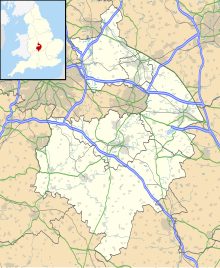RAF Bramcote
|
RAF Bramcote |
|||||||||||||||||||
|---|---|---|---|---|---|---|---|---|---|---|---|---|---|---|---|---|---|---|---|
| Summary | |||||||||||||||||||
| Airport type | Military | ||||||||||||||||||
| Operator | Royal Air Force (RAF) | ||||||||||||||||||
| Location | Bramcote | ||||||||||||||||||
| Built | 1939 | ||||||||||||||||||
| In use | 1940-1946 RAF use 1946-1959 RN use |
||||||||||||||||||
| Elevation AMSL | 354 ft / 113 m | ||||||||||||||||||
| Coordinates | 52°29′23″N 001°23′57″W / 52.48972°N 1.39917°WCoordinates: 52°29′23″N 001°23′57″W / 52.48972°N 1.39917°W | ||||||||||||||||||
| Map | |||||||||||||||||||
| Location in Warwickshire | |||||||||||||||||||
| Runways | |||||||||||||||||||
|
|||||||||||||||||||
RAF Bramcote is a Royal Air Force station located 4 miles (6.4 km) south-east of Nuneaton, Warwickshire, England during the Second World War. It later became HMS Gamecock and then Gamecock Barracks.
The airfield was built by John Laing & Son in the late 1930s. The first unit to use the airfield was No. 215 Squadron RAF who joined on 10 September 1939 with the Vickers Wellington and the Avro Anson before leaving on 8 April 1940.
The next unit to use the station was No. 18 (Polish) Operational Training Unit (OTU) flying the Vickers Wellington which arrived from RAF Hucknall during June 1940. The unit used RAF Bitteswell and RAF Nuneaton as satellites between February 1942 and February 1943. However soon after this the OTU moved to RAF Finningley during March 1943.
During the Battle of Britain No. 300 Polish Bomber Squadron was formed at the airfield on 1 July 1940 with the Fairey Battle I before moving to RAF Swinderby on 22 August 1940 accompanied by No. 301 Polish Bomber Squadron which formed 21 days later and left for Swinderby 6 days later on the 28th.
These squadrons were replaced by No. 304 Polish Bomber Squadron and No. 305 Polish Bomber Squadron which formed at the airfield during August 1940 flying Battle I's and switched to Vickers Wellington IC's during November 1940 before moving to RAF Syerston on 2 December 1940.
...
Wikipedia

